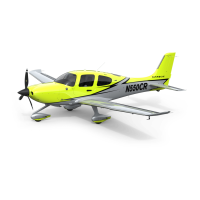24-30
Page 12
All
EFFECTIVITY:
CIRRUS AIRPLANE MAINTENANCE MANUAL MODELS SR22 AND SR22T
15 Dec 2014
Serials w/ Perspective Avionics: Main and Essential Bus voltages are shown graphically and as text in
the electrical data field located in the mid-right section of the MFD and are also continuously displayed
in the voltage parameters field located in the mid-left corner of the PFD. The MFD and PFD receive the
voltage signals via the GEA 71 engine airframe interface as measured directly off the Main and Essen-
tial Buses.
In the event Main Bus voltage is less than 24.5v or exceeds 32.0v the MFD will display “Check Main
Bus” in a yellow advisory box in the lower right corner of the MFD.
In the event Essential Bus voltage is less than 24.5v or exceeds 32.0v the MFD will display “Check
Essential Bus” in a red advisory box in the lower right corner of the MFD.
Alternator 1, Alternator 2, and Battery 1 ampere output are shown graphically and as text in the electri-
cal data field located in the mid-right section of the MFD. The MFD and PFD receive the amp signals
via the GEA 71 engine airframe interface as derived from current shunts located in the MCU.
In the event Alternator 1 or Alternator 2 ampere output is less than 2 amps for 20 seconds or more, the
MFD will display a CAS warning on the MFD.
28 VDC for the digital instrument operation is supplied through the 3-amp ENGINE INSTR circuit
breaker on the Essential 2 Bus.
I. Ammeter Select Switch (See Figure 24-308)
Serials 22-0002 thru 22-1601, 22-1603 thru 22-1643, 22-1645 thru 22-1662: An ammeter select switch
is located on the right instrument panel and is labeled distinctly. The ammeter select switch controls
which output reading the ammeter will display the voltage from ALT 1, ALT 2 or the BAT 1 or BAT 2.
The ammeter will also display the state of charge or discharge either battery is in. The amps indication
is derived from a current transducer located in the electrical system MCU. When the engine is operat-
ing and the BAT 1 switch is turned on, the ammeter indicates the charging rate applied to battery 1.
Due to the inability of the alternators to dissipate current, the alternator ammeter indications are posi-
tive only.
Serials 22-1602, 22-1644, 22-1663 & subs: Main and Essential Bus voltages are displayed on the
MFD and PFD, therefore, no ammeter select switch is necessary.
J. Battery 1 (See Figure 24-309)
Serials w/ TCM Battery: Battery 1 is a 24-volt, 12-cell,10-ampere hour, lead-acid aviation-grade type
battery with non-spill vent caps. The battery is mounted in the engine compartment and has a top vent
with an acid-resistant tube. The tube discharges out the bottom of the engine cowling, preventing the
build up of dangerous or explosive gasses within the engine cowl.
Serials w/ Concorde Battery: Battery 1 is a 24-volt, valve regulated, lead-acid aviation-grade type bat-
tery. The battery is mounted in the engine compartment.
The battery is used for engine starting and can also be used as an emergency power source in the
event Battery 2 or either alternator fails. Battery 1 provides all the electrical power for starting the air-
craft. Battery 1 also supplies the electrical power to the landing light in the event Alternator 1 fails. Bat-
tery 1 is independently controlled by the BAT 1 switch, located in the pilot’s bolster panel. The BAT 1
switch energizes a relay in the MCU which will connect BAT 1 to the Main Distribution Bus.
K. Battery 2 (See Figure 24-3010)
Serials w/o Perspective Avionics: Battery 2 is a maintenance free rechargeable sealed lead acid bat-
tery. The battery consists of two 12-volt, 6-cell, 7-amp-hour batteries connected in series to provide 24-
VDC to the Essential Bus. There is no need to check the specific gravity of the electrolyte or add water
to these batteries during their service life.
Serials w/ Perspective Avionics: Battery 2 is a maintenance free rechargeable sealed lead acid battery.
The battery consists of two 12-volt, 6-cell, 18-amp-hour batteries connected in series to provide 24-
VDC to the Essential Bus. There is no need to check the specific gravity of the electrolyte or add water
to these batteries during their service life.

